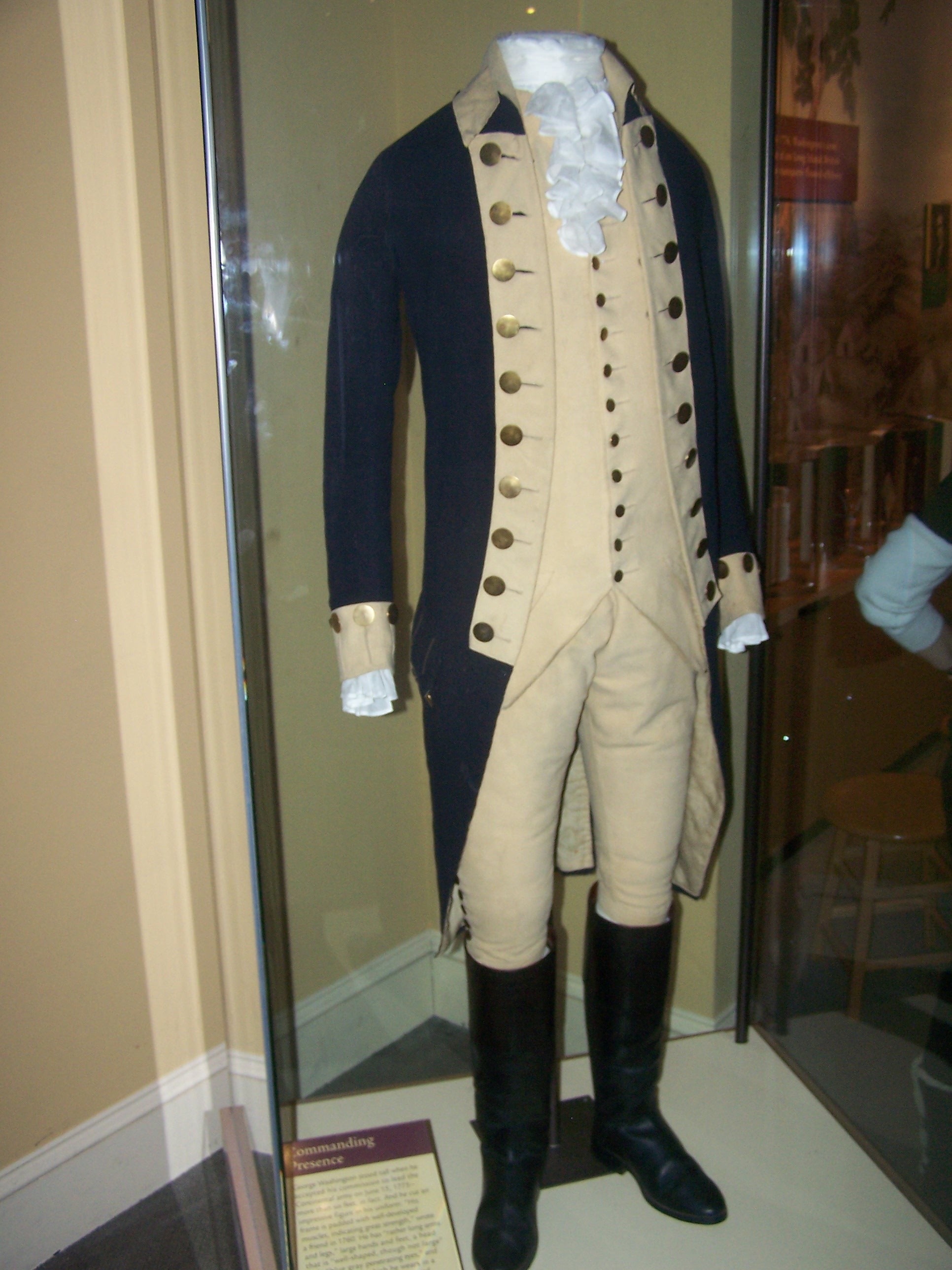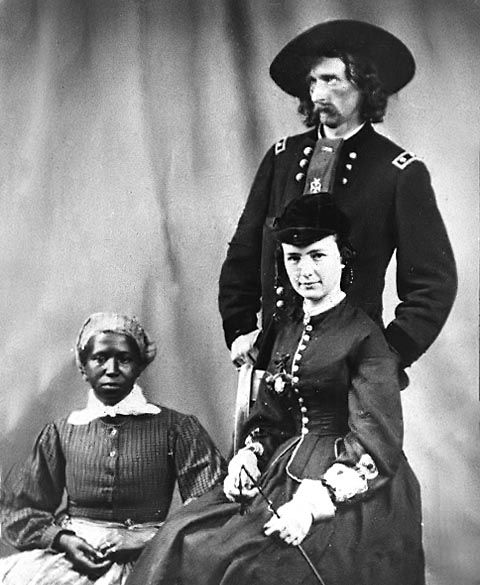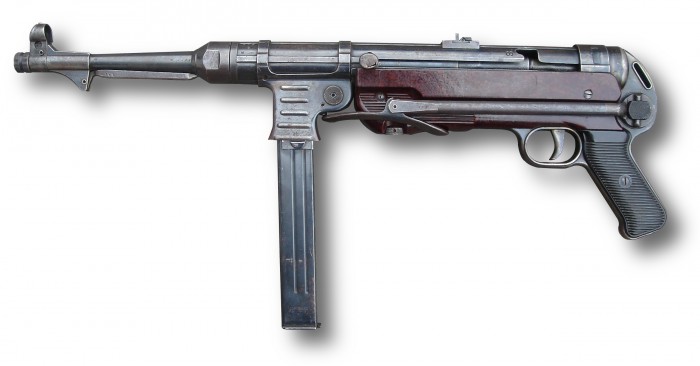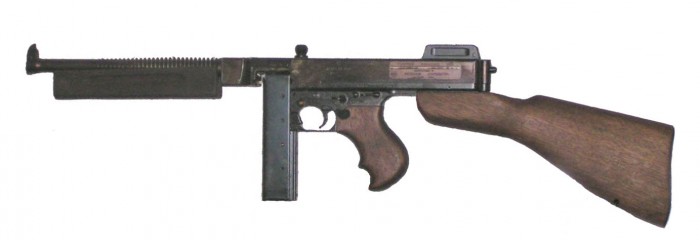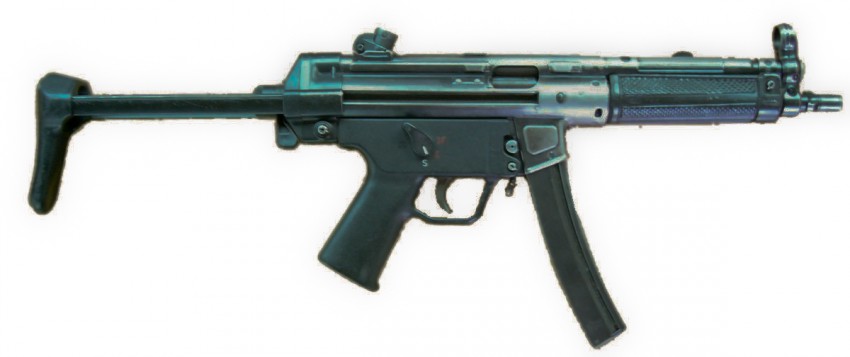Tag: American History
American History: George Washington’s Uniform
This blue wool coat is part of a suit of regimentals made for George Washington in 1789. It has a buff wool rise-and-fall collar, buff cuffs and lapels, and buff lining; there is a row of yellow metal buttons on each lapel, as well as on each cuff.
The waistcoat and breeches are matching buff wool, with gilt buttons.
Specific History
This uniform consisting of coat, waistcoat, and knee breeches was initially donated to the Columbian Institute; in 1841, it was transferred to the National Institute and housed in the Patent Office. It came to the Smithsonian in 1883 from the Patent Office collection, and has been on display almost continuously. (From the years 1942 to 1944, during World War II, the Smithsonian packed up many of its treasured artifacts, including this uniform, and sent them to the Shenandoah Valley for safekeeping.)
This uniform was worn by George Washington from 1789 until his death in 1799; the small clothes, or breeches and waistcoat, date from the revolutionary period.
Washington often posed for life portraits during this period, and was often depicted wearing this uniform. An example is the watercolor portrait on ivory painted by John Ramage in 1789; it is the first known depiction of this uniform in a portrait of Washington.
In December 1798, Washington was recorded wearing this uniform when he visited Philadelphia on Provisional Army duty. He wore a similar uniform when he was commissioned by the Continental Congress as commander in chief of the Continental army.
None of his uniforms from the Revolutionary War period are known to have survived.
General History
When George Washington was an aide to General Edward Braddock he paid special attention to the way the British general maintained his rank and deportment. Washington believed that in order to command effectively, an officer must convey character and leadership through appearance as well as action. As the leader of the Continental army, Washington wanted these troops to present themselves as a professional military organization and a proper uniform was one way of showing a unified front. In commemoration of Washington’s attention to detail, the colors of blue and buff remained the accepted pattern for U.S. Army uniforms until the beginning of the Civil War.
Top 5 Submachine Guns
The submachine gun was born from the desire of war-planners to provide the basic infantryman with the voluminous firepower of a machine gun with the portability of a pistol in the early part of the 20th Century – the requirement proved most apparent during World War 1. The first useful submachine gun design was of German origin and became the Bergmann MP18. However, it would not be until World War 2 that the submachine gun would truly take the stage as a viable infantry weapon as its use was prevalent on all sides of the conflict. The war produced the reliable American M1 Thompson, the war-winning British STEN series and the famous German MP38/MP40 types. The Germans ushered in an all-new era of submachine gun design during the Cold War years with the introduction of the excellent Heckler & Koch MP5 which went on to be used by dozens of countries the world over.
The submachine gun is falling quickly into obsolescence, but they still fill a few important roles and are incredibly fun to shoot. In this episode of TFBTV, we look at the top 5 best sub-guns factoring in historical significance and effectiveness.
We also had to have some honorable mentions as it would be sinful to leave them out!
MP40
The MP 40 was a submachine gun chambered for the 9×19mm Parabellum cartridge. It was developed in Nazi Germany and used extensively by the Axis powers during World War II.
Designed in 1938 by Heinrich Vollmer with inspiration from its predecessor the MP 38, it was heavily used by infantrymen, paratroopers, platoon and squad leaders on the Eastern and Western Front. Its advanced and modern features made it a favorite among soldiers and popular in countries from various parts of the world after the war. It was often erroneously called “Schmeisser” by the Allies, despite Hugo Schmeisser’s non-involvement in the weapon’s design and production. From 1940 to 1945, an estimated 1.1 million were produced by Erma Werke.
Thompson Submachine Gun
The Thompson submachine gun (nicknamed the Thompson) is an American submachine gun, invented by John T. Thompson in 1918, that became infamous during the Prohibition era. It was a common sight in the media of the time, being used by both law enforcement officers and criminals.
The Thompson was also known informally as: the “Tommy Gun”, “Trench Broom”, “Trench Sweeper”, “Chicago Typewriter”, “Chicago Piano”, “Chicago Style”, “Chicago Organ Grinder”, and “The Chopper”.
The Thompson was favored by soldiers, criminals, police and civilians alike for its large .45 ACP cartridge, accuracy, and high volume of automatic fire. It has since gained popularity among civilian collectors for its historical significance.
Walther MPL
The Walther MP series is a family of 9×19mm Parabellum submachine guns produced in West Germany from 1963 to 1985 by Walther.
There are two versions of the Walther MP: the MPK short machine pistol and the MPL long machine pistol”. The only difference between MPK and MPL guns is the length of the barrel.
They are blowback designs firing from “L”-shaped bolts. The bolts are above the barrel, permitting a shorter receiver. The receiver, made from stamped steel, forms a ventilated cooling jacket and the prominent cocking handle is located on its left front. A selective fire switch is also on both the left and right side of the receiver, behind the trigger, allowing for ambidextrous use.
Uzi
The Uzi is a family of Israeli open-bolt, blowback-operated submachine guns. Smaller variants are considered to be machine pistols. The Uzi was one of the first weapons to use a telescoping bolt design which allows the magazine to be housed in the pistol grip for a shorter weapon.
The first Uzi submachine gun was designed by Major Uziel Gal in the late 1940s. The prototype was finished in 1950. First introduced to IDF special forces in 1954, the weapon was placed into general issue two years later. The Uzi has found use as a personal defense weapon by rear-echelon troops, officers, artillery troops and tankers, as well as a frontline weapon by elite light infantry assault forces.
The Uzi has been exported to over 90 countries. From the 1960s through the 1980s, more Uzi submachine guns were sold to more military, law enforcement and security markets than any other submachine gun ever made.
HK MP5
The MP5 is a 9mm submachine gun of German design, developed in the 1960s by a team of engineers from the German small arms manufacturer Heckler & Koch. There are over 100 variants of the MP5, including a semi-automatic version.
The MP5 is one of the most widely used submachine guns in the world, having been adopted by 40 nations and numerous military, law enforcement, intelligence, and security organizations. It is widely used by SWAT teams in North America.


